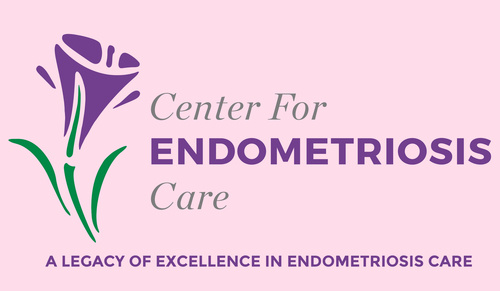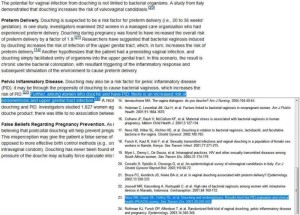Image via The Forgotten History Blog.
Cover image used with licensed permission. © Center for Endometriosis Care/Ken Sinervo MD, MSc, FRCSC. All rights reserved. No reproduction permitted without written permission. Revised since original publication and current as of 2023. No external funding was utilized in the creation of this material. The Center for Endometriosis Care neither endorses nor has affiliation with any resources cited herein. The following material is for informational purposes only and does not constitute medical advice.
Lysol was once advertised and used as both a douche and form of birth control. Read more at The Forgotten History Blog. Image © The Forgotten History
Does douching cause endometriosis?
Of course not.
In the mid-80s, a popular study was released in which the authors suggested that “douching may increase risk of endometriosis, by increasing retrograde menstruation” [Cramer DW, Wilson E, Stillman RJ, et al. The relation of endometriosis to menstrual characteristics, smoking and exercise. JAMA. 1986;255:1904-1908]. The study was among others of similar nature, all based on the same presumptions. This has long been contradicted by multiple, more recent data, not the least of which is valid contention against the theory of retrograde menses as a sole cause of endometriosis.
Nearly thirty years later, despite evidence to the contrary, articles related to the disease and the practice of douching persist, as seen here. Many of the claims are sourced to a variation on theme of a single citation; “Douching: Perceived Benefits but Real Hazards” by W. Steven Pray & Joshua J. Prey. That article was originally published in U.S. Pharmacist in 2004, but has been reprinted in full online at a reputable website, where it remains a top hit for string searches on endometriosis+douching. In the article, authors state (emphasis ours):
“[A]mong women who douche and have PID, there is an *increased risk of endometriosis* and upper genital tract infection.”
PID, or endometritis, is an inflammation or irritation of the lining of the uterus; it is not the same as endometriosis [National Library of Medicine]. That statement is cited to the following reference (emphasis ours):
Ness RB, Soper DE, Holley RL, et al. Douching and endometriosis: Results from the PID evaluation and clinical health (PEACH) survey. Sex Transm Dis. 2001;28:240-245.
Unfortunately, use of a single incorrect word in the reference as cited has led to repetition of the claim, with many sourcing that article’s same words.
Image: screenshot excerpts from http://www.medscape.com/viewarticle/490338. Click image to enlarge.
The ACTUAL study reference is (emphasis ours):
Ness RB, Soper DE, Holley RL, Peipert J, Randall H, Sweet RL, et al. Douching and endometritis: results from the PID evaluation and clinical health (PEACH) study. Sex Transm Dis. 2001 Apr;28(4):240-5.
Specifically: that study – the PEACH trial – was designed to “examine the association between douching and PID in a large, multicenter, clinical trial of PID after adjustment for race/ethnicity.” It examined 654 women who had signs and symptoms of PID – not endometriosis. Authors concluded that “[a]mong a predominantly black group of women with clinical PID, frequent and recent douching was associated with endometritis and upper genital tract infection.“
The word “endometriosis” does not appear in that study, yet it continues to be widely cited as a source of confirmation regarding the claim that endometriosis and douching are linked. Other, even earlier studies are also sometimes cited, yet none ever claimed more than a speculative link between douching, retrograde menses and endometriosis.
Even the influential American Public Health Association cited the same claim in their public policy statement “Vaginal Douching & Adverse Health Outcomes“, though they correctly cite the title in their own references:
“A study of douching and endometriosis found that recent and frequent douching in a group of women with clinical pelvic inflammatory disease was associated with endometritis and upper genital tract infections in those women with normal or intermediate vaginal flora.”
By contrast, in a study not without its own controversy, Meaddough et al. hypothesized that in part, “douching at the time of menstruation would serve to heighten the chances of developing endometriosis.” Instead, the authors found that “[t]he majority of cases and controls never douche. No significant differences were revealed between cases and controls regarding douching during menstruation, when not menstruating, or both;” and that “the findings ran counter to those concepts that had caused us to initiate the study.” To wit: douching did not cause endometriosis in their study subjects. [Meaddough EL, Olive DL, Gallup P, Perlin M, Kliman HJ. Sexual activity, orgasm & tampon use are associated with a decreased risk for endometriosis. Gynecol Obstet Invest. 2002;53(3):163-9]
In another related study to determine the effects of vaginal douching specifically on fertility itself [Baird, Weinberg, Voigt, Daling. Vaginal douching and reduced fertility. Am J Public Health. 1996 June; 86(6): 844–850], authors concluded there was a potential link between douching and reduced fertility; however, they maintained that “further research is needed to determine whether the relationship is casual and, if so, to what extent it is mediated by pelvic infection“; specifically noting that “few women in [the study sample] had been diagnosed with endometriosis, and douchers were *not more likely to report being diagnosed with the condition than non-douchers.*” (Emphasis ours)
While the American College of Obstetricians & Gynecologists (ACOG) recommends that women do not douche, that recommendation is largely related to infections and vaginal flora – not endometriosis. For more, click here. Other evidence exists contrary to the claim that douching causes endometriosis.
In closing, there is no confirmed data linking vaginal douching as a cause of the disease whatsoever.



